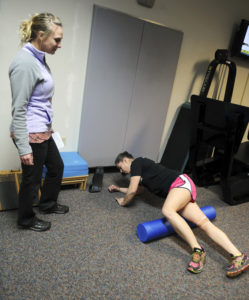by exercise physiologist Polly de Mille, RN, MA, RCEP, CSCS, USAT, Hospital of Special Surgery, special to SportsMD.com

From your local gym to your physical therapists’ office, foam rollers can be found everywhere; there are even full classes dedicated to teaching athletes how to properly roll. Whether someone is a recreational exerciser, weekend warrior or professional athlete, foam rolling is necessary to aid in injury prevention, performance and recovery.
What is foam rolling and why is it necessary?
Foam rolling is a self-massage technique utilized to rehydrate the fascia, the connective tissue that surrounds the muscles. When the fascia is at its healthiest, it is flexible and agile. However, overuse of muscles or inactivity can cause the fascia to bind together with the underlying muscle, which can cause knots or ‘trigger points.’ Foam rolling can ultimately help release these trigger points so the fascia can return to its elastic and healthy state.
On May 11, National Foam Rolling Day, over 150 people at Madison Square Garden participated in one of the world’s largest foam rolling exercise lessons. Below are some of the key takeaways from the event.
What are the best ways to foam roll?

Foam rolling can and should be done pre and post workout.
Pre-Workout
Foam rolling can help activate muscles by increasing blood flow to areas, which can help increase overall mobility and flexibility. Ultimately, this can help prevent excessive stress and tension to the muscles, which could cause muscle fibers to strain.
Post-Workout
Foam rolling can also serve as an effective cool-down method upon completion of a workout. During the National Foam Rolling Day event, participants foam rolled following an IronStrength workout. Foam rolling immediately after a workout can ultimately help promote the circulation of metabolic wastes, which can aid in muscle recovery and reducing post-workout soreness.
What are any other tips?
Foam rolling can be a great recovery tool; however, there are certain guidelines to keep in mind for optimal results. When foam rolling, always stick to rolling muscles, rather than ligaments like the IT band or joints like knees, elbows, low back, and neck. Additionally, avoid foam rolling directly on an injury. Instead, roll adjacent tissues and gradually introduce rolling to the injured area as healing progresses, always using tolerable pressure. You should never feel pain after rolling.
For best results, foam roll on a daily basis! Just like exercise, results can be short lived, so make sure to be consistent with rolling techniques.
Overall, foam rolling is for everyone, even if you don’t have the ability to get down onto a foam roller, there are other self-myofascial tools such as sticks, small rollers and small lacrosse or tennis balls that would allow anyone to reap the benefits of self-myofascial release.

